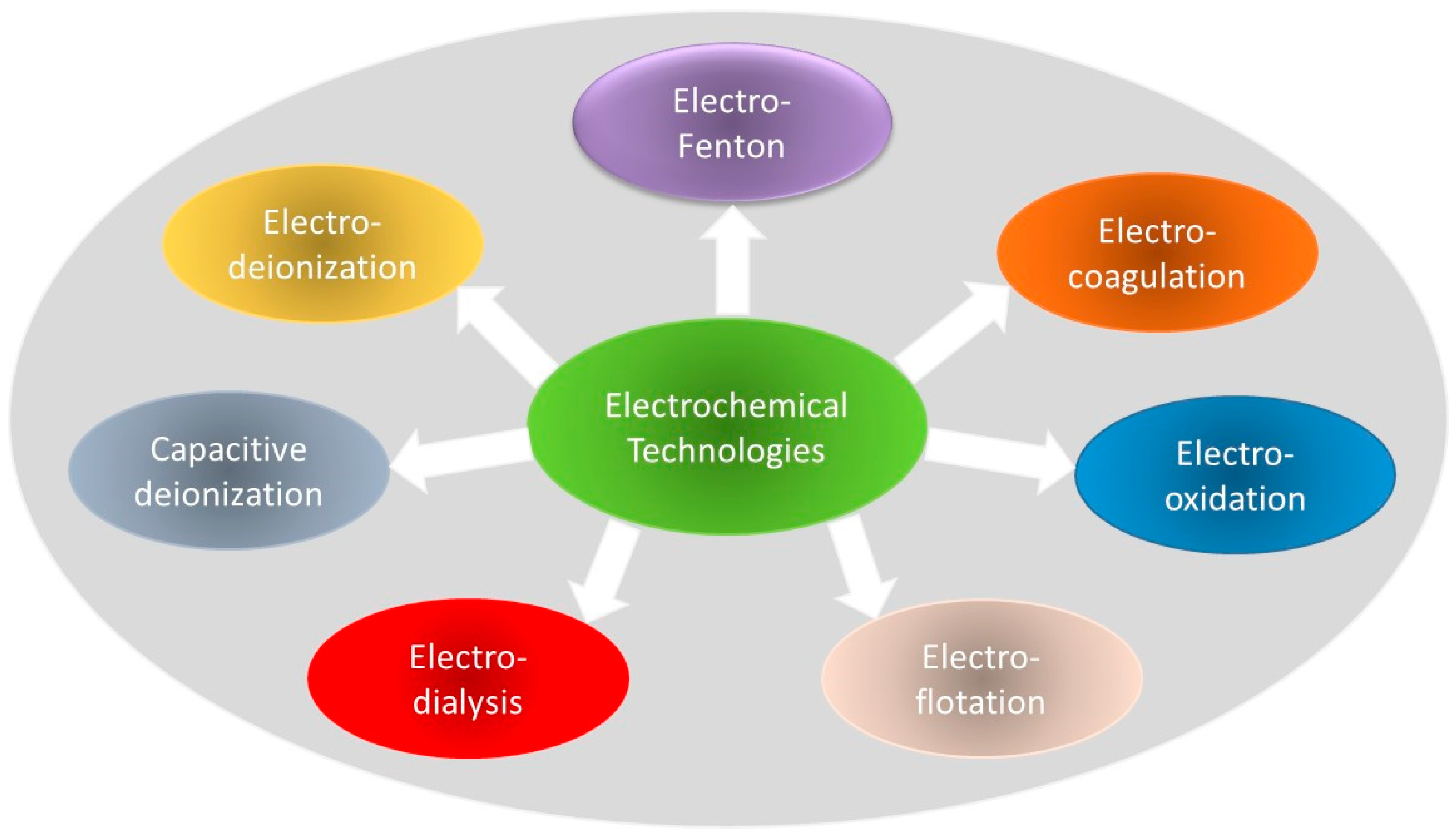Considerations on Electrochemical Technologies for Water Purification and Wastewater Treatment
Conflicts of Interest
References
- Mao, Y.; Zhao, Y.; Cotterill, S. Examining Current and Future Applications of Electrocoagulation in Wastewater Treatment. Water 2023, 15, 1455. [Google Scholar] [CrossRef]
- Signorelli, S.C.M.; Costa, J.M.; Almeida Neto, A.F. Electroflocculation for Wastewater Treatment of Textile Industry: Overview and Process Variables Effects. In Advanced Oxidation Processes in Dye-Containing Wastewater; Muthu, S.S., Khadir, A., Eds.; Springer: Singapore, 2022; Volume 2, pp. 297–316. [Google Scholar]
- WHO. World Health Statistics 2022 (Monitoring Health of the SDGs); WHO: Geneva, Switzerland, 2022. [Google Scholar]
- United Nations. The Sustainable Development Goals Report 2022; United Nations: New York, NY, USA, 2022. [Google Scholar]
- Ghanbari, F.; Wu, J.; Khatebasreh, M.; Ding, D.; Lin, K.-Y.A. Efficient treatment for landfill leachate through sequential electrocoagulation, electrooxidation and PMS/UV/CuFe2O4 process. Sep. Purif. Technol. 2020, 242, 116828. [Google Scholar] [CrossRef]
- Cheng, D.; Ngo, H.H.; Guo, W.; Chang, S.W.; Nguyen, D.D.; Liu, Y.; Wei, Q.; Wei, D. A critical review on antibiotics and hormones in swine wastewater: Water pollution problems and control approaches. J. Hazard. Mater. 2020, 387, 121682. [Google Scholar] [CrossRef] [PubMed]
- Signorelli, S.C.M.; Costa, J.M.; Almeida Neto, A.F.d. Electrocoagulation-flotation for orange II dye removal: Kinetics, costs, and process variables effects. J. Environ. Chem. Eng. 2021, 9, 106157. [Google Scholar] [CrossRef]
- Costa, J.M.; Costa, J.G.R.; Almeida Neto, A.F. Techniques of nickel(II) removal from electroplating industry wastewater: Overview and trends. J. Water Process Eng. 2022, 46, 102593. [Google Scholar] [CrossRef]
- Nepel, T.C.M.; Costa, J.M.; Vieira, M.G.A.; Almeida Neto, A.F. Copper removal kinetic from electroplating industry wastewater using pulsed electrodeposition technique. Environ. Technol. 2022, 43, 469–477. [Google Scholar] [CrossRef] [PubMed]
- Moreira, F.L.; Costa, J.M.; Almeida Neto, A.F. Anticorrosive Zn–Ni alloys: An alternative for the treatment of electroplating industry wastewater. Sustain. Chem. Pharm. 2020, 16, 100263. [Google Scholar] [CrossRef]
- AlJaberi, F.Y.; Ahmed, S.A.; Makki, H.F.; Naje, A.S.; Zwain, H.M.; Salman, A.D.; Juzsakova, T.; Viktor, S.; Van, B.; Le, P.-C.; et al. Recent advances and applicable flexibility potential of electrochemical processes for wastewater treatment. Sci. Total Environ. 2023, 867, 161361. [Google Scholar] [CrossRef] [PubMed]
- Ren, Y.; Zheng, W.; Duan, X.; Goswami, N.; Liu, Y. Recent advances in electrochemical removal and recovery of phosphorus from water: A review. Environ. Funct. Mater. 2022, 1, 10–20. [Google Scholar] [CrossRef]
- Du, J.; Waite, T.D.; Biesheuvel, P.M.; Tang, W. Recent advances and prospects in electrochemical coupling technologies for metal recovery from water. J. Hazard. Mater. 2023, 442, 130023. [Google Scholar] [CrossRef] [PubMed]
- Mohanakrishna, G.; Al-Raoush, R.I.; Abu-Reesh, I.M. Integrating electrochemical and bioelectrochemical systems for energetically sustainable treatment of produced water. Fuel 2021, 285, 119104. [Google Scholar] [CrossRef]
- Sato, Y.; Zeng, Q.; Meng, L.; Chen, G. Importance of Combined Electrochemical Process Sequence and Electrode Arrangements: A Lab-scale Trial of Real Reverse Osmosis Landfill Leachate Concentrate. Water Res. 2021, 192, 116849. [Google Scholar] [CrossRef]
- Cuprys, A.; Thomson, P.; Ouarda, Y.; Suresh, G.; Rouissi, T.; Kaur Brar, S.; Drogui, P.; Surampalli, R.Y. Ciprofloxacin removal via sequential electro-oxidation and enzymatic oxidation. J. Hazard. Mater. 2020, 389, 121890. [Google Scholar] [CrossRef]
- Wang, C.; Li, T.; Yu, G.; Deng, S. Removal of low concentrations of nickel ions in electroplating wastewater by combination of electrodialysis and electrodeposition. Chemosphere 2021, 263, 128208. [Google Scholar] [CrossRef] [PubMed]
- Costa, J.G.d.R.d.; Costa, J.M.; Almeida Neto, A.F.d. Recent advances and future applications in electro-adsorption technology: An updated review. J. Environ. Chem. Eng. 2021, 9, 106355. [Google Scholar] [CrossRef]
- Sahu, P. A comprehensive review of saline effluent disposal and treatment: Conventional practices, emerging technologies, and future potential. J. Water Reuse Desalin. 2020, 11, 33–65. [Google Scholar] [CrossRef]
- Li, X. Development in electrochemical technology for environmental wastewater treatment. Int. J. Electrochem. Sci. 2022, 17, 2212110. [Google Scholar] [CrossRef]
- Saravanan, A.; Yaashikaa, P.R.; Senthil Kumar, P.; Karishma, S.; Thamarai, P.; Deivayanai, V.C.; Rangasamy, G.; Selvasembian, R.; Aminabhavi, T.M. Environmental sustainability of toxic arsenic ions removal from wastewater using electrodeionization. Sep. Purif. Technol. 2023, 317, 123897. [Google Scholar] [CrossRef]

Disclaimer/Publisher’s Note: The statements, opinions and data contained in all publications are solely those of the individual author(s) and contributor(s) and not of MDPI and/or the editor(s). MDPI and/or the editor(s) disclaim responsibility for any injury to people or property resulting from any ideas, methods, instructions or products referred to in the content. |
© 2023 by the author. Licensee MDPI, Basel, Switzerland. This article is an open access article distributed under the terms and conditions of the Creative Commons Attribution (CC BY) license (https://creativecommons.org/licenses/by/4.0/).
Share and Cite
Costa, J.M. Considerations on Electrochemical Technologies for Water Purification and Wastewater Treatment. Int. J. Environ. Res. Public Health 2023, 20, 6140. https://doi.org/10.3390/ijerph20126140
Costa JM. Considerations on Electrochemical Technologies for Water Purification and Wastewater Treatment. International Journal of Environmental Research and Public Health. 2023; 20(12):6140. https://doi.org/10.3390/ijerph20126140
Chicago/Turabian StyleCosta, Josiel Martins. 2023. "Considerations on Electrochemical Technologies for Water Purification and Wastewater Treatment" International Journal of Environmental Research and Public Health 20, no. 12: 6140. https://doi.org/10.3390/ijerph20126140




